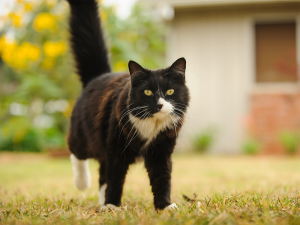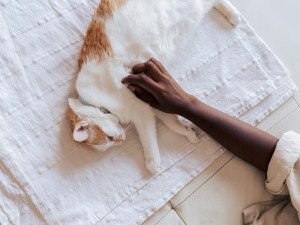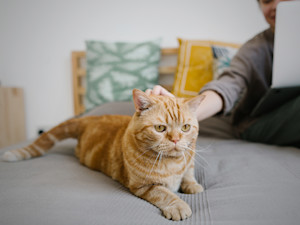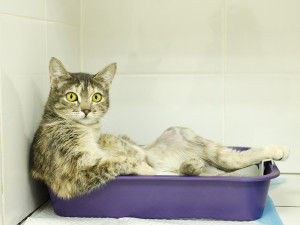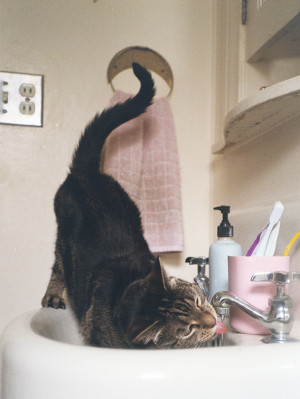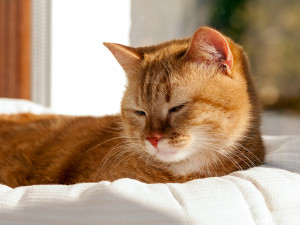What to Know About Tapeworms in Cats
The evidence is unmistakably gross when your cat gets an infection. But the (very) good news is that the treatment is pretty effective.
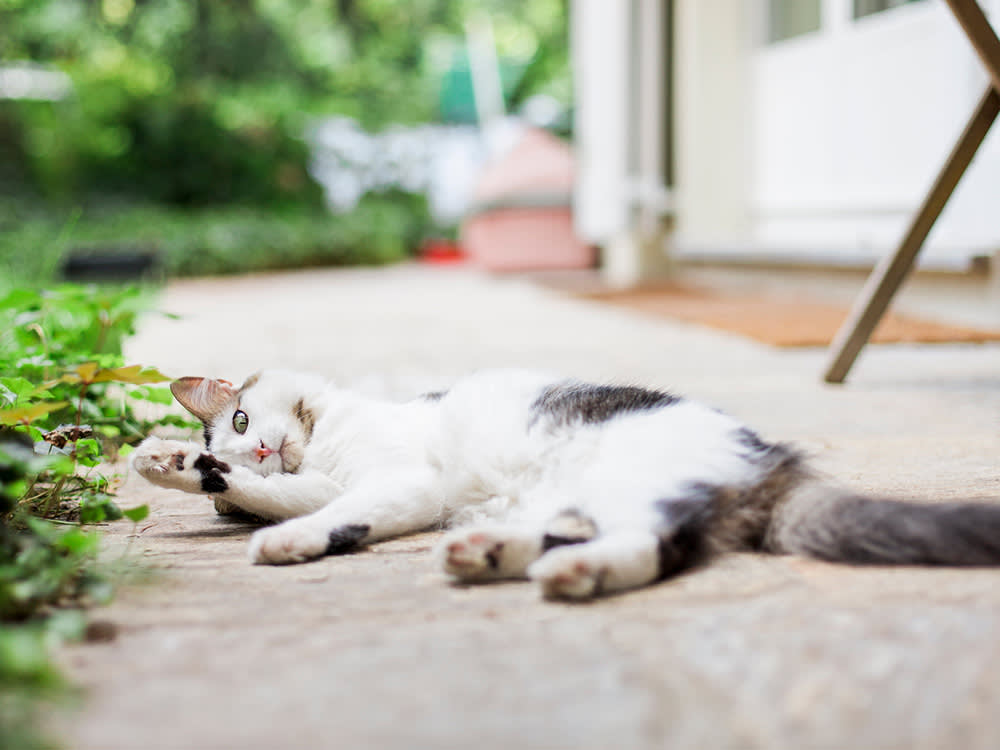
Share Article
In This Article:
What Tapeworms Are How Cats Get Tapeworms Symptoms of Tapeworms Diagnosing Tapeworms Treating Tapeworms in Cats Recovery and Management of Tapeworms How to Prevent Tapeworms Risks of Tapeworms to People and Pets in Households
Why is it that vets love to compare things affecting animals to food? Nobody wants their vet to overload them with veterinary jargon, so instead, we choose to put things in terms everyone can relate to. That’s why you’ll get questions such as, “Do they look like grains of rice or spaghetti noodles?” when we ask you to describe the worms you may be seeing in your cat’s feces or around their anus.
We’re not trying to put you off your upcoming lunch — instead, we’re trying to figure out the type of worm your cat is dealing with. Roundworms and hookworms kind of resemble spaghetti noodles, while tapeworms look like little pieces of rice, if rice could move itself around. Now that you’re sufficiently grossed out, let’s talk about the ones that are short like rice.
How much do you spend on your pet per year?

What tapeworms are
Tapeworms are flat, segmented parasites and one of the more common worms that infect cats and dogs. Dipylidium caninum — the fancy, scientific name for the most common tapeworms in cats — set up shop in a cat’s small intestine. They hook on to the intestinal wall and suck nutrients from the cat.
While the bits of tapeworm visible externally are pretty small, the actual worm inside a cat can grow to a whopping six inches to over two feet long. As tapeworms grow, they develop segments called proglottids. These egg-bearing proglottids break off from the tail end of the tapeworm and are passed in the cat’s feces into the environment, where the eggs are released. These are the little things that look like grains of rice in an infected cat’s poop.
How cats get tapeworms
Dipylidium tapeworms infect cats through fleas. Animals infected with tapeworms will pass tapeworm eggs (in proglottids) in their feces. Once in the environment, the eggs can get ingested by flea larvae, where they remain; both the tapeworm egg and the flea larvae mature together. The flea can then find itself a cat to infest — the cat will inadvertently ingest the flea while grooming. The mature tapeworm eggs hatch and are then free to attach to the lining of the cat’s small intestine to start the cycle over again.
An important thing to note is that fleas are a necessary part of the process. A cat won’t get tapeworms by eating tapeworm eggs directly.
Symptoms of tapeworms in cats
Cats with tapeworms may lick and groom their hind ends excessively. That area likely needs a little extra attention — after all, worms are crawling out of their butts. Some cats may scoot their butts on the ground. The main clue that a cat has tapeworms is seeing the proglottids directly.
The tiny, rice-like segments can be found near the cat’s anus or on the cat’s feces. Despite the disturbing visuals, cats with tapeworms typically feel fine and will have normal energy and appetite levels, though some may have vomiting and diarrhea. Especially heavy burdens may cause weight loss.
Diagnosing tapeworms in cats
The most common (and most reliable) way to diagnose tapeworms in cats is by directly watching the little buggers crawl around a cat’s butt or poop. A fecal exam is less reliable than direct observation, but it may be recommended to rule out other intestinal parasites.
Treating tapeworms in cats
Treating tapeworms in a cat requires deworming with specific products, which means a trip to a veterinarian. Not all dewormers will do the job. Deworming is essential to kill the tapeworms, but it’s not the only step. Deworming must be combined with flea control to be effective long-term. This includes treating all pets in the household with flea medications, and then ridding the environment of them by washing bedding and vacuuming regularly. All steps should be performed at the same time and repeated regularly to catch all life stages of the fleas.
Recovery and management of tapeworms in cats
If your cat has tapeworms, don’t worry: Even if your kitty gets infected with tapeworms, recovery is usually uneventful following treatment. Tapeworms tend not to leave any lasting effects, but they can reinfect very quickly after treatment, so prevention is important to spare your kitty another go-around.
How to prevent tapeworms in cats
Your best course of action to keep your cat tapeworm-free is to keep up with flea preventatives. This method is win-win, as it not only keeps your kitty from experiencing tapeworms, but it also keeps fleas off your cat and out of your household.
Risks of tapeworms to people and pets in households
A cat with tapeworms cannot directly transmit tapeworms to other people or pets. But both people and pets can be infected if they ingest an infected flea. This is more commonly reported in children and can be prevented by staying on top of flea preventatives and washing your hands after petting your cat.
Additional risks for cats who hunt
Cats can also get a different species of tapeworm called Taenia. Taenia species are transmitted by eating infected rodents. The life cycle for this tapeworm is a little different. Instead of a flea eating tapeworm-infected feces, a rodent ingests them. The eggs develop into larvae and travel to the rodent’s liver, where they develop in cysts. After a cat catches the infected rodent and has a nice meal, the tapeworm larvae mature into adult tapeworms in the cat’s intestines.
Symptoms and treatments for Taenia tapeworms are basically the same as Dipylidium tapeworms, so there’s no need to try to differentiate between the two. Taking measures to prevent a cat from hunting, like keeping them indoors, is the best prevention for Taenia tapeworms.
Bottom line
Tapeworms are a common intestinal parasite in cats that attach to the lining of the small intestine. They release small egg sacks, called proglottids, that look like grains of rice.
Cats can be infected with tapeworms by ingesting either an infected flea or an infected rodent.
Tapeworms are typically easily treated and don’t cause any lasting effects, but it’s best to prevent infections by using a veterinary-prescribed flea preventative.
FAQs
Are certain cats more likely to get tapeworms?
There isn’t a breed or gender who’s more likely to get tapeworms. Instead, cats who have flea issues or hunt are more likely to get tapeworms than those who don’t.
How do indoor cats get tapeworms?
Indoor cats can get tapeworms by ingesting an infected flea. Fleas can hitch a ride on another pet or even on us, and then infect them.
Are cat tapeworms contagious to humans?
Tapeworms aren’t directly contagious to humans from cats, though humans can get tapeworms at the same time as their cat by ingesting an infected flea.
References
“About Dog or Cat Tapeworm Infection.” Centers for Disease Control. 19 Dec 2023. https://www.cdc.gov/dipylidium/about/index.htmlopens in new tab.

Dr. Chyrle Bonk, DVM
Dr. Chyrle Bonk has been a mixed-animal veterinarian since 2010, with a special interest in rehabilitation. When she's not practicing or writing about veterinary medicine, you may find her exploring the outdoors with her family or tending to her cows, horses, chickens, or cats and dogs.

Dr. Alycia Washington, DVM, MS
Alycia Washington is a small-animal emergency veterinarian with over 10 years of experience based in North Carolina. She works as a relief veterinarianopens in new tab and provides services to numerous emergency and specialty hospitals. She also works as a veterinary writer with a focus on educating pet parents.
Related articles
![Unrecognizable woman petting an ill cat]()
5 Common Types of Cancer in Cats, Symptoms, and Treatments
Learn how to spot the early signs to how to treat them.
![White Persian cat on a blue background]()
UTIs Suck for Your Cat, Too
Here’s how to help them get relief.
![Owner pets senior ginger cat.]()
6 Common Health Concerns in Senior Cats
How to spot and how to treat them.
![cat sitting in a litter box]()
How to Deal with Cat Diarrhea
Dr. Audrey K. Cook’s tips to getting to the bottom of a sh*tty situation.
![Tabby cat leaning into a porcelain sink, tail curled in the air, as it sticks its tongue out to drink water from the faucet.]()
Why Is My Cat So Damn Thirsty?
No, not like that. They’re literally drinking a lot of water. Here’s when you should be worried.
![Red cat with squinted eyes laying in a basket closeup]()
6 Ways Your Cat Could Tell You They Are in Pain
Here are all the way your kitty is trying to tell you they’re hurting.

